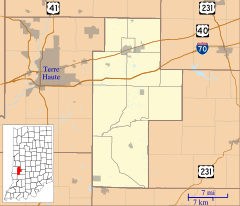Bowling Green, Indiana facts for kids
Quick facts for kids
Bowling Green
|
|
|---|---|
 |
|
| Country | United States |
| State | Indiana |
| County | Clay |
| Township | Washington |
| Elevation | 653 ft (199 m) |
| Time zone | UTC-5:00 (EST) |
| • Summer (DST) | UTC-5:00 (EDT) |
| ZIP code |
47833
|
| Area code(s) | 812 |
| FIPS code | 18-06832 |
| GNIS feature ID | 431404 |
Bowling Green is a small, unincorporated town located in Washington Township, Clay County, Indiana. An "unincorporated town" means it's a community without its own local government. It is part of the larger Terre Haute area.
History of Bowling Green
Bowling Green likely got its name from a town called Bowling Green, Virginia. The first post office in Bowling Green, Indiana, opened its doors in 1825. This was an important step for the growing community.
In the same year, Clay County was officially created. Bowling Green was chosen as the very first county seat. This meant it was the main town where the county's government and important offices were located. The first courthouse was finished in 1828.
Bowling Green officially became an incorporated town in 1869. However, it later lost its status as the county seat. In 1876, the town of Brazil became the new county seat instead.
Population Changes Over Time
The number of people living in Bowling Green has changed quite a bit over the years. The U.S. Census recorded its population from 1850 to 1960.
| Historical population | |||
|---|---|---|---|
| Census | Pop. | %± | |
| 1850 | 318 | — | |
| 1860 | 466 | 46.5% | |
| 1870 | 606 | 30.0% | |
| 1880 | 572 | −5.6% | |
| 1890 | 467 | −18.4% | |
| 1900 | 432 | −7.5% | |
| 1910 | 336 | −22.2% | |
| 1920 | 273 | −18.7% | |
| 1930 | 257 | −5.9% | |
| 1940 | 219 | −14.8% | |
| 1950 | 235 | 7.3% | |
| 1960 | 229 | −2.6% | |
| U.S. Decennial Census | |||
The town's population was highest in 1870. At that time, 606 people were reported to be living in Bowling Green.
Famous People from Bowling Green
- George N. Beamer: He was an important person in law and government. George N. Beamer served as a judge for the United States District Court for the Northern District of Indiana. He was also the 30th Indiana Attorney General, which means he was the chief legal officer for the state of Indiana.


